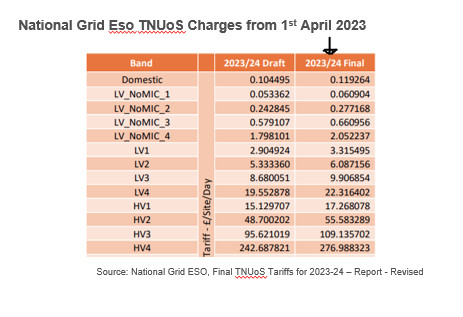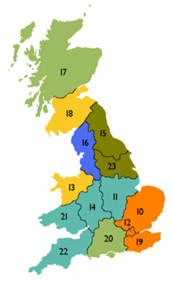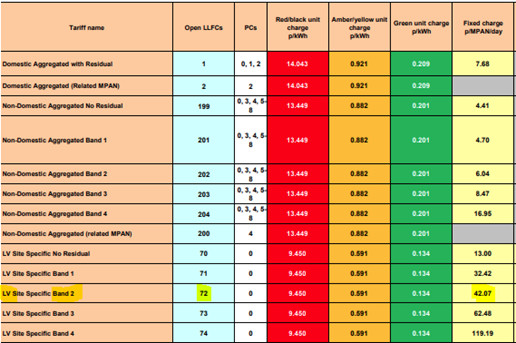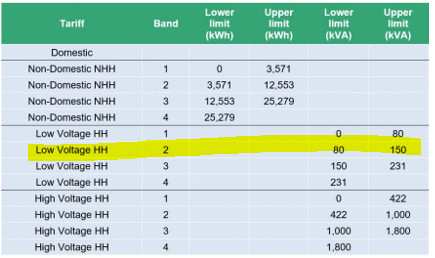Home > AF explains the Targeted Charging Review
AF explains the
Targeted Charging Review
AF Renewable Energy Specialist Catherine Williams, also known as our standing charges expert, explains what the Targeted Charging Review is, how is affects your electricity site(s) and what AF can do about it.
What is the Targeted Charging Review?
In 2019 Ofgem set out to modernise the electricity network charging and make it fairer for all. One of the reviews conducted under this overarching goal was the Targeted Charging Review (TCR).
The TCR examined ‘residual charges’ which recover the costs of maintaining the electricity networks that supply energy, and the differences in charges for smaller and larger sites.
The TCR allocated sites into specific charging bands by the type of site (Low Voltage (LV), High Voltage (HV) and Extra High Voltage (EHV)) and average annual consumption for non half-hourly sites or average agreed supply capacity for half hourly sites.
This was split into two deliveries:
- From 1stApril 2022, the new Distribution Use of System Charges (DUoS) were implemented.
- From 1stApril 2023, the new Transmission Use of System Charges (TNUoS) were implemented.
Here are examples of DUoS and TNUoS charges.


When will my banding be reviewed?
Ofgem will review the charging banding periodically, and implement effective from the beginning of each network price control period (referred to as RIIO).
The current banding was calculated over the two-year period from October 2018 to September 2020.
The band reallocations for the next price control period will use data from the 2-year period October 2023 – September 2025, and will be effective from 1st April 2026.
Can my site be reallocated before April 2026 if my consumption has changed since 2018-2020?
The charging framework sets out that a site may be reallocated to a different charging band if “the site has a change of use or change of site configuration, and this is reflected by a significant change to its:
(i) Maximum Import Capacity
(ii) Forecast annual consumption”
The framework sets out that “significant change” means that the agreed supply capacity and/or consumption must have either increased or decreased by more than 50 percent in comparison to the agreed supply and/or consumption used for the purposes of the allocation.
In short, if you reduce your usage, or agreed supply capacity by less than 50%, your charging band will remain the same, even if the change puts your site as better suited to a different band.
If you reduce your usage, or agreed supply capacity by more than 50%, your charging band can be reviewed subject to your Distribution Network Operator’s satisfaction that this criterion has been met.
How can I work out which band my site is in?
At the bottom of your latest bill, you will see the full coded MPAN.
To work out what band your site is in, you will need to look at the below two highlighted sections:

The MPAN Area Code, which is the first box on the bottom line. In the above example this is 10.
The Loss Line Factor Code, which is the last box on the top line. In the above example this is 072.
Your MPAN Area Code will identify who your Distribution Network Operator (DNO) is. The map below shows these. Please note, if your Area Code is 24-38, you do not have a DNO, you have an “IDNO” (Independent Distribution Network Operator) and there will not be a geographic area associated.

You will then need to navigate to your DNO (or IDNO’s) latest charging statement. You can get the link to the one you need from our table below.
The links to Area Codes 10 – 23 will take you straight to the charging statement for 2023/24. You will need to look at Annex 1.
The links to Area Codes 25 – 29 will take you to the IDNO webpage with the zip file download link as they split areas into zones labelled alphabetically.
If you have any difficulty accessing or understanding the charging statement for your DNO/IDNO, then please do not hesitate to contact me.
Area Code | DNO/IDNO Name | 2023/24 Charging Statement Link |
10 | UK Power Networks | |
11 | National Grid Electricity Distribution | |
12 | UK Power Networks | |
13 | Scottish Power | |
14 | National Grid Electricity Distribution | |
15 | Northern Power Grid | |
16 | Electricity North West | |
17 | Scottish Hydro Electric Power Distribution plc | |
18 | Scottish Power | |
19 | UK Power Networks | |
20 | Southern Electric Power Distribution plc | |
21 | National Grid Electricity Distribution | |
22 | National Grid Electricity Distribution | |
23 | Northern Power Grid | |
25 | ESP Electricity | |
26 | Energetics Electricity Ltd | |
27 | The Electricity Network Company Ltd | |
29 | Harlaxton Energy Networks |
Using the example MPAN above, we’ve opened UK Power Networks Charging Statement for Area Code 10 and navigated to Annex 1 which you can see below.

Source: UK Power Networks, Use of System Charging Statement 2023/24
You will now need to remind yourself of the Loss Line Factor Code (LLFC) shown on your full coded MPAN. For the example we’re using, this is 072. Search for the LLFC in the Open LLFCs column to identify which tariff name your site has. Our example, it is in LV Site Specific Band 2 highlighted on the below list of banding.

How can AF help you?
Using the exception clause to the banding framework we’ve mentioned above, we can apply to your Distribution Network Operator to reallocate your site to a lower banding with immediate effect.
We have already analysed data for the half-hourly sites in our portfolio to identify sites where there is potential to save money on capacity charges and sites where a re-band might also be possible. We are contacting you if your sites have been identified under this review.
It is more difficult to identify the non-half hourly sites as meter reads can be inconsistent and invoice history based instead on supplier estimates. Similarly, if your site was not connected until after 2020, your Distribution Network Operator will have used the details provided on the connection application, or the usage data they have obtained since the site was connected to assign a band. This is not always correct.
If you have a non-half hourly site where usage has changed by more than 50% since September 2020, a site connected after 2020 that seems to be overcharged, or a half-hourly site with agreed supply capacity set too high and have not been contacted, then please do get in touch so we can see if there is a case to be made.
Your AF Renewables Team
renewables@af.farm 01603 881 894
Glossary
Ofgem: Great Britain’s independent energy regulator. Their role is to protect consumers by working to deliver a greener, fairer energy system.
DNO: Distribution Network Operator – Responsible for operating the networks that connect sites to the national transmission system.
IDNO: Independent Distribution Network Operator – Adopt new, installed assets, such as connections to new developments, which will connect back onto the DNO’s network. Unlike DNOs, they do not have a specific geographical area.
RIIO: Revenue = Incentives + Innovation + Outputs – Network Price Control period set by Ofgem.
Low Voltage, High Voltage & Extra High Voltage: Determined by the number of volts of the connection and categorises sites for charging purposes under TCR.
Half Hourly site: Identifiable by “00” MPAN Profile.
Non-Half Hourly site: Identifiable by “01-04” MPAN Profile.
National Grid ESO: The electricity system operator for Great Britain. Responsible for ensuring that electricity is transported safely, securely and reliably from where it is produced to the DNOs.
TNUoS: Transmission Network Use of System – charges incurred for transmitting electricity across the National Grid network from the source of generation to the network of the local distribution company.
DUoS: Distribution Use of System – Published costs made by each DNO/IDNO for delivering electricity from the Grid Supply Point to the customer’s premises.



